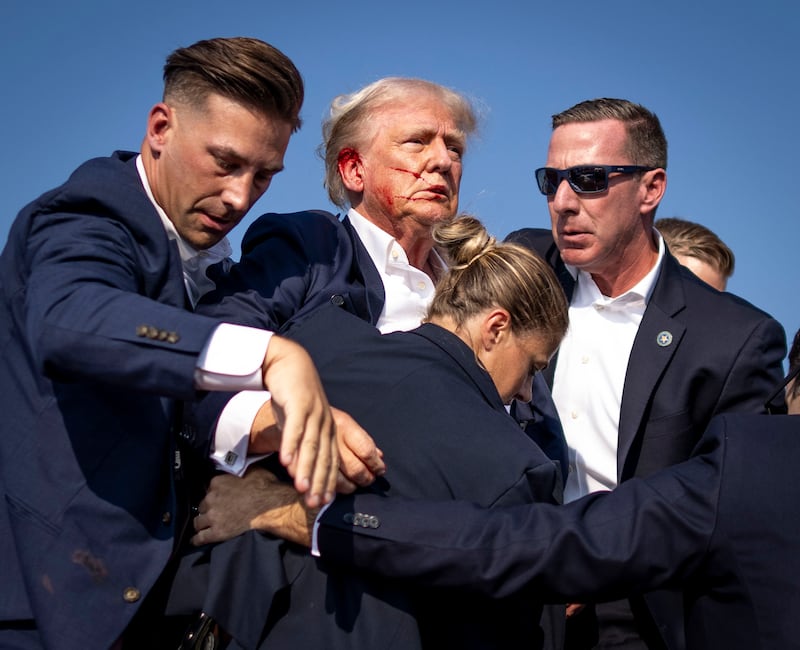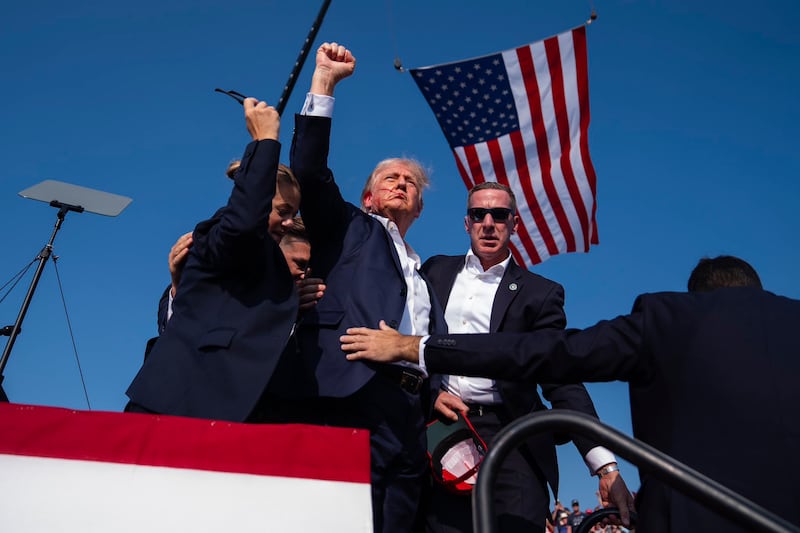These are historic images, the instantaneous consensus went. We will be talking about them decades from now, it was confidently and reasonably stated. Long before details of the gunman and the fatal damage he inflicted in Butler, Pennsylvania, were released, the verdict was in. Iconic, extraordinary and, that word again, historic.
If journalism is the first draft of history, photojournalism is the essence of the draft that survives to the final record intact – or, at least, in our stubbornly old-school, pre-meme, pre-AI way of thinking, that’s the expectation.
In the wake of the attempted assassination of Donald Trump, the professional excellence of photographs by Evan Vucci of Associated Press, Doug Mills of the New York Times and Anna Moneymaker of Getty Images – hers include the one of Trump’s bloodied face between the legs of secret service agents – have been rightfully extolled.


Among them, the single image to have garnered the most attention and praise is Vucci’s version of the fist-pump moment in which Trump is framed by grave-faced agents – one of them appearing to stare directly down the lens – as they try to rush him off stage.
Far-right leaders freed by Trump talk of desire for retribution
Democratic-led states take legal action against Trump’s birthright citizenship order
Trump executive orders: What we know about the orders targeting immigration, climate, TikTok and more
Donald Trump returns to strike sombre tone of vindication and providential intercession
The quality of Vucci’s composition is inarguable. Blue sky, red smears, stars and stripes (upside down). Chaos, violence, dark shades. All of it is present in one colourful clash.

But the immediacy of the reaction tells its own story. Because by “historic”, it seemed what many commentators were alluding to was not that this photograph and other similar ones had captured a moment in history, but their (sinking) feeling that they possessed the power to change it.
What was, for everybody else, a portent, manifested to the Maga faithful as a thrilling celebration of Trumpism. Even among pundits who aspire to neutral observation, there were carefully grudging statements about the king of reality television’s defiance under attack.
Just as there are people who will mystifyingly insist that Nigel Farage is charismatic no matter what your politics are, election-watchers queued up to explain that Trump’s fist-pump was objectively heroic, admirable and legacy-defining. Is bravado aspirational? To many, it is, yes, so much so that they can’t see why anyone would not lap it up the same way they do.
It would be wrong to call these interpretations of events in Pennsylvania a self-fulfilling prophecy, not least because Joe Biden and the Democrats have lately been conspiring to lose the White House anyway. At most, it would appear that the failed assassination and Trump’s initial response to it has only sealed the deal of a second term for the former president, who already has millions of Americans subscribing to election denialism and who, less than two months ago, was convicted of 34 felony counts.
Among the black-is-white takes now doing the rounds is the idea that it is media rhetoric about Trump that has posed and continues to pose a danger to US democracy, not Trump rhetoric about the media and the 2020 election, not his revisionist history of the January 6th insurrection.
The reality is that Trump’s stint as president led to such a climate of hostility for the truth that even a Fox News anchor was blaming him for making the most direct, sustained assault on media freedom in US history. (That was Chris Wallace, who works for CNN now, but still.)
We often used to hear about the “Trump bump”, or evidence that cable networks profited from higher ratings and certain newspapers from a spike in clicks triggered by his 2016 campaign to become president.
For most, it didn’t last. The Trump era instead coincided with a surge in news avoidance in the US, as measured by the Reuters Institute for the Study of Journalism in its annual reports. People on the left switched off because of the negative effect that the president and his administration had on their mood. People on the right swerved mainstream media in sympathy with Trump’s repeated declarations that it was all just “fake news”.
This has compounded the pre-Trump pattern of structural decline for both print newspapers and linear television, which – together with tech sector dominance of online advertising – has left much of the surviving US media in a more precarious place than it was eight years ago. Fatalism and fatigue sparked by the Biden v Trump re-run has done little to halt cord-cutting or subscriber churn.
At the top of the media tree, however, the question of who should occupy the White House notably only extends as far as which candidate will be the most business-friendly in its aftermath.
Last week, before it all kicked off in Pennsylvania, David Zaslav, the chief executive of CNN parent company Warner Bros Discovery, declined to take sides in the election.
Speaking at investment firm Allen & Co’s Sun Valley Conference, an annual billionaires’ shindig where the dress code is likely the only thing that’s casual, Zaslav was only interested in which candidate would be most keen to approve any future merger & acquisition (M&A) activity involving Warner Bros Discovery (which is itself the debt-laden product of a recent mega-merger).
“We just need an opportunity for deregulation, so companies can consolidate and do what we need to, to be even better,” he told Bloomberg.
That this attitude is unsurprising doesn’t make it any less chilling. Indeed, it would be tough to find a clearer expression of qualm-free capitalist greed. Sometimes you don’t need an iconic, extraordinary, historic photograph to fill you with foreboding. Sometimes 21 words of corporate-speak is more than enough to explain why things are the way they are.
- Sign up for Business push alerts and have the best news, analysis and comment delivered directly to your phone
- Find The Irish Times on WhatsApp and stay up to date
- Our Inside Business podcast is published weekly - Find the latest episode here
















